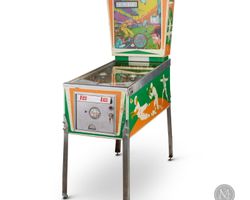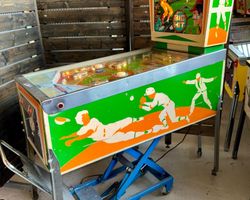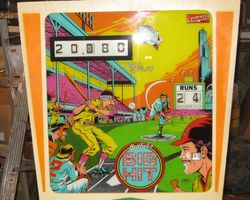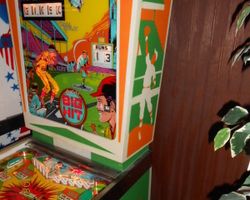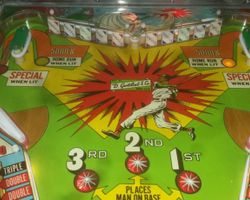Big Hit
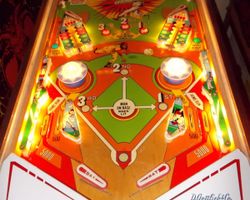
Average Prices: USD $400 to $1,100
Produced: March, 1977
Production Run: 2,200 units
Machine Type: Electro-mechanical
Players: 1
Design by: Ed Krynski
Art by: Gordon Morison
History and Background
In March 1977, D. Gottlieb & Company, a manufacturer with a substantial history in pinball, introduced "Big Hit" to the market. This electro-mechanical (EM) machine, model number 400, tapped into a universally appealing theme: baseball. Gottlieb had a long-standing tradition of producing sports-themed machines, and "Big Hit" continued this lineage by integrating the familiar elements of America's pastime directly into the gameplay.
The design of "Big Hit" was spearheaded by Ed Krynski, a designer known for his thoughtful playfield layouts and ability to maximize the capabilities of EM technology. The visual identity of the machine was crafted by Gordon Morison, whose artwork on the backglass and playfield captured the essence of a vibrant baseball stadium and its energetic players. The machine's production run saw 2,313 units manufactured, with 1,478 designated for domestic sales and 722 for export, in addition to 113 sample games produced earlier in 1977, as evidenced by internal Gottlieb documentation.
An interesting facet of "Big Hit's" production history involves the materials used for its playfield. Amidst fluctuating plywood prices, Gottlieb experimented with alternative materials. Consequently, some "Big Hit" playfields were made from chipboard, particularly in areas typically left as unpainted woodgrain between the lower flippers and in the top arch. To conceal the chipboard's texture, these areas were painted either white or yellow, leading to "standard," "white," and "yellow" versions of the playfield in circulation. This detail highlights a period of material innovation and adaptation within pinball manufacturing. Another distinctive design choice was the automatic ball launch system, where the ball enters play from the outhole through the lower flippers, initiated by pressing the right flipper button, foregoing a traditional plunger.
Signature Features and Design
"Big Hit" distinguishes itself through several key design elements that directly influence its gameplay and aesthetic appeal. Foremost among these are its four flippers, including a pair of larger, three-inch flippers at the bottom of the playfield and another pair positioned in the upper playfield. These larger flippers are designed to deliver powerful shots, enabling players to execute dynamic maneuvers across the playfield.
The machine’s baseball theme is reinforced by its dual scoring system: players accumulate both conventional points and "runs." This innovative approach effectively translates the objective of a baseball game into pinball mechanics, providing two distinct goals to pursue during play. Scoring "runs" often triggers a satisfying chime, adding a sonic layer to the accomplishment.
Two banks, each containing five drop targets, are central to the upper playfield. These targets represent a primary objective, demanding precision and strategic aiming. Complementing these are two vari-targets, situated near the pop bumpers, which offer variable scoring based on how deeply they are pushed back by the ball. The absence of traditional slingshots above the lower flippers also marks a notable design departure, affecting the ball's rebound dynamics and the overall flow of the game. Two pop bumpers and three star rollovers further populate the playfield, contributing to the random action and scoring opportunities. The ball's unique launch mechanism, exiting the outhole directly between the lower flippers when the right flipper button is pressed, is a signature characteristic, removing the conventional shooter lane entirely.
Playfield and Mechanics
The playfield of "Big Hit" is laid out to evoke a baseball diamond, with strategic elements positioned to facilitate the game's dual-scoring objective. The lower section is dominated by the two large, three-inch flippers, providing ample power to send the ball upfield. Unusually, there is no dedicated shooter lane; instead, the ball is introduced directly onto the playfield from the outhole, between the flippers, a process initiated by the player's right flipper button press.
Moving up the playfield, two pop bumpers are situated centrally, contributing to chaotic ball movement and unexpected rebounds. Flanking these bumpers are the two vari-targets, which present a unique challenge. Their positioning can sometimes make them difficult to hit precisely, or even obscured by the pop bumpers, requiring players to adapt their shot angles. Above these, in the upper portion of the playfield, are two distinct banks of five drop targets each. These ten drop targets are critical for scoring and are often the primary focus of players aiming for higher point values and "runs." The upper pair of flippers, also three-inch, are strategically placed to engage these drop target banks and offer opportunities for powerful, precise shots in the upper third of the playfield. Three star rollovers are interspersed, typically offering bonus points or activating special features when rolled over.
The playfield’s artwork, rendered by Gordon Morison, features a vibrant baseball stadium, complete with stylized players and stands, maintaining a cohesive theme. The coloring is bright and appealing, creating an engaging visual experience that aligns with the era's aesthetic. Lighting is functional, highlighting key scoring areas and objectives. The design philosophy emphasizes direct shots and target elimination, with the four flippers providing multiple angles of attack. The lack of slingshots means ball movement relies more heavily on direct hits from flippers, pop bumper deflections, and the interaction with drop and vari-targets, influencing a distinct flow different from many machines of the period.
Gameplay Dynamics
"Big Hit" offers a gameplay experience centered on its innovative dual-scoring system and a direct, target-oriented approach. The primary objectives revolve around hitting the two banks of five drop targets and skillfully manipulating the vari-targets to accumulate both points and "runs." Each successful hit on a drop target contributes to points, and completing a bank often progresses the player towards scoring a "run." The machine's design encourages players to use the powerful three-inch flippers to smash through the drop targets. Once a bank of drop targets is completed, they reset, either at the end of a ball or upon achieving certain special conditions, setting up continuous engagement.
The vari-targets, located near the pop bumpers, add another layer of challenge and scoring. These targets reward players based on the force and depth of the hit, providing variable point values. Mastering shots to these targets requires precision, as they can be difficult to consistently hit, sometimes obscured by the pop bumpers.
The progression in "Big Hit" is straightforward yet engaging: players accumulate points, and as point thresholds are met, "runs" are scored. The sound of the bell chiming for a "run" provides an immediate and satisfying auditory reward, reinforcing the baseball theme. Achieving "home runs" or lighting specials by hitting difficult shots, such as the top corner rollovers, offers significant rewards and a sense of accomplishment. The game's straightforward objectives, combined with the powerful flippers and the satisfaction of clearing drop target banks, create a compelling gameplay loop. Strategies often involve systematically clearing the drop targets, then using the upper flippers to repeatedly engage the reset banks for continuous scoring, while also aiming for the vari-targets for additional points. The unique ball launch system, where the ball is propelled from the outhole between the flippers, means players forgo a traditional skill shot from a plunger lane, instead focusing on immediate playfield control.
Reception and Legacy
"Big Hit" generally garnered a positive reception among pinball enthusiasts and collectors, often regarded as a strong example of Gottlieb's electro-mechanical machines from the late 1970s. Its primary strength, frequently cited by players, is its engaging and enjoyable gameplay. Many consider it a "keeper" in their collections, highlighting its capacity for repeat play without quickly losing its appeal. The dual scoring system, allowing players to accumulate both points and baseball "runs," is consistently praised as a design triumph that perfectly aligns with the baseball theme, giving the impression of "two games in one" and adding strategic depth.
The inclusion of four large, three-inch flippers, particularly the pair situated in the upper playfield, is another widely appreciated feature. These flippers enable powerful shots and facilitate challenging "trick shots," contributing to a dynamic and often fast-paced game. The banks of drop targets are also well-received, providing satisfying feedback and clear objectives. The distinct ball launch from the outhole, utilizing the right flipper button rather than a traditional plunger, is a notable and often celebrated unique feature, though a minority of players found it less appealing due to the absence of a conventional skill shot. The machine's artwork by Gordon Morison, especially the cabinet and backglass, frequently earns commendation for its aesthetic appeal and vibrant coloring. The bell sound that accompanies scoring "runs" adds to the thematic immersion.
Despite these strengths, "Big Hit" is not without its criticisms. Some players found the game to be "a bit too easy" or repetitive over extended play sessions, particularly for experienced players seeking deeper complexity. The vari-targets proved to be a polarizing feature; while some appreciated the challenge they presented, others found them poorly placed or difficult to hit effectively, occasionally leading to frustration. A recurring point of discussion is the absence of slingshots above the lower flippers. For some, this design choice resulted in a slower playfield or a feeling of a "void," suggesting that their inclusion might have made the game more "alive" with increased ball agitation. The symmetrical playfield layout was also noted by some, contributing to a perception of a "weird layout" or a certain predictability in ball movement.
"Big Hit" maintains its reputation as a solid Gottlieb EM, particularly for collectors who appreciate the distinct characteristics of the era. Its innovative dual-scoring and unique ball launch method set it apart. Its influence is seen in how it pushed the boundaries of EM design, exploring alternative playfield flow and scoring mechanics. It stands as a testament to Gottlieb's willingness to experiment with fundamental elements like flipper size and ball launch, leaving a mark on pinball history as a machine that, while having its quirks, delivers a memorable and often captivating experience.
Sponsored Links
 Ebay Listings
Ebay Listings
 Auction Results
Auction Results
| Cost | Location | Date |
|---|---|---|
| EUR €1,300 |  Nordrhein-Westfalen, Germany Nordrhein-Westfalen, Germany |
18 April, 2025 |
| USD $1,800 |  Pennsylvania, United States Pennsylvania, United States |
09 February, 2025 |
| CAD $800 |  Canada Canada |
09 December, 2023 |
| USD $1,600 |  Minnesota, United States Minnesota, United States |
06 November, 2022 |
| USD $1,100 |  Missouri, United States Missouri, United States |
11 December, 2021 |
| USD $668 |  Pennsylvania, United States Pennsylvania, United States |
28 November, 2018 |
| USD $750 |  Idaho, United States Idaho, United States |
15 September, 2015 |
| USD $1,300 |  Michigan, United States Michigan, United States |
21 June, 2015 |
| USD $900 |  California, United States California, United States |
26 January, 2015 |
| USD $665 |  Maryland, United States Maryland, United States |
08 December, 2014 |


Private Policy · Search Website · Contact Us
As an eBay Partner, we may earn a commission from qualifying purchases made through links on this site, at no additional cost to you.
All trademarks and copyrighted materials remain property of their respective owners. All other content copyright 2007 - 2025 Pinpedia.

